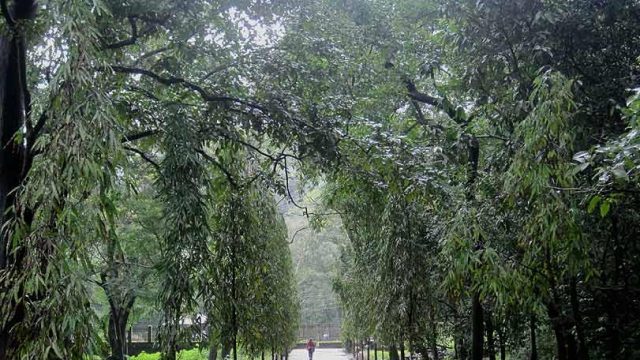The rain gods must be really happy today, I thought when I stepped out of Dabolim airport in Goa, as it was pouring hard. The 25km drive to our hotel in Fontainhas gave us enough time to drink in the wonderfully green landscape and gaze at the Zuari River bridge from a flyover running parallel to it. Our hotel, WelcomHeritage Panjim Inn in Goa’s old Latin Quarter, looked freshly painted after the downpour. This heritage property, with antique furniture and four-poster beds, was constructed in 1880 and is among the oldest mansions in Fontainhas.
An early morning Saturday in Fontainhas kicked off with GoaInstawalk, organised by Goa Tourism. Thanks to the ever-expanding reach of technology, now we all have the urge to post our current whereabouts on social media. The InstaWalk is just like any other photo-walk, but requires individuals to share their photos on Instagram – instantly, of course. Well, speaking for myself, I am still learning the art of photography without using those filters.
A two-hour drive from Fontainhas to Tambdi Surla, towards the eastern part of Goa, was our first location for the walk. It was a magnificent experience: looking out of the window, staring into nothingness, just absorbing the fresh clean air and admiring the lush greenery and that sound of natural gushing streams running along the roadside as we went deep into the forest.
After a 65km drive through narrow roads and tiny bridges, we arrived at Tambdi Surla. The moist walkway that led us towards the Mahadev Temple had pastel-coloured stones as flooring and also rivulets branching off Surla river near the main entrance. The temple, locally known as the Tambdi Surla temple, is located on Anmod Ghat. The Jain-style temple dedicated to Lord Shiva was built in the 12th century with black basalt stones. The Mahadev Temple is the only existing creation of the Kadamba Yadava dynasty, making it one of the oldest temples in Goa that also survived Muslim conquest and Portuguese oppression, solely because of its remote location. The temple has complex and beautiful ancient carvings of elephants, horses and lotus flowers. There is also a headless Nandi, the bull that is the vehicle of Lord Shiva – the Mahadev Temple is said to be incomplete.
After a compelling walk around the historic temple, we proceeded to Harvalem waterfalls in Sanquelim village. I had always dreamt of witnessing a waterfall during monsoon, and here was my chance to make the most of it. We had to climb up a flight of stairs that ended in something like a balcony, the closest one could get to the rushing waterfall. Too bad there was no chance of a Bollywood-style drenching, but I leaned out and felt the spray on my face. Then, as an InstaWalker without an Instagram app, I made a video of the visit.
We did get a chance to get wet, wet, wet, though – if only a little bit. The water tumbling down the Harvalem falls flows out and forms a shallow stream nearby where one can walk through the water, balancing carefully on the bedrock.
Most people go to the Harvalem caves before seeing this waterfall, though we did it the other way round. The caves, dating back to the 5th century, are also known as ‘Pandava caves’ because many believe that the five Pandavas from the Mahabharata sought refuge here. Others believe that these caves belonged to Buddhist monks. Carved out of one huge laterite rock, the caves are ascetic with no special features. The Harvalem waterfalls are a five-minute walk from these caves.
Sunday morning started with the chirping of birds and light rain showers that I could listen to from my heritage room. The drizzle soon turned into a heavy shower but that didn’t stop Jack Ajit Sukhija, partner at Panjim Inn and also the organiser of Heritage Walks in Fontainhas, from showing us around. The walk started from Tobacco Square, where the last attempt was made to revive the failing Goan economy by initiating tobacco production. The building is now the General Post Office of Goa.
Right before the Sao Tome chapel, you can see a statue of Miguel Caetano Dias, the first Goan doctor to be honoured by the Portuguese Medical Corps. As you walk through Fontainhas, you would come across classic Portuguese-style yellow, red and blue houses; the old Latin Quarter is still steeped in the rich European culture and charm. Jack Ajit Sukhija told us that there were no white houses in Fontainhas, as the locals believed that white was meant only for holy places like churches and chapels.
Roads like 31st January Road and 18th June Road take a visitor back to some legendary moments of Goan history. On 18th June Road, you would see one of the oldest bakeries in Goa, Confeitaria 31 De Janeiro. Towards the other end of Fontainhas, there is the Fountain of Phoenix, a water reservoir from which the name Fontainhas has originated. The locals say that from the road going uphill from the reservoir towards the Maruti temple, you can see one of the idols of lord Hanuman set up inside the temple.
This is a very refreshing part of Goa, so far removed from the regulation beaches and the Mangeshi temple visit of the usual ‘city tour’. As is apt for all ‘well-connected’ travellers, we finished the day with a group selfie, everyone all smiles.
For more information regarding the upcoming events in Goa, visit www.goatourism.gov.in




